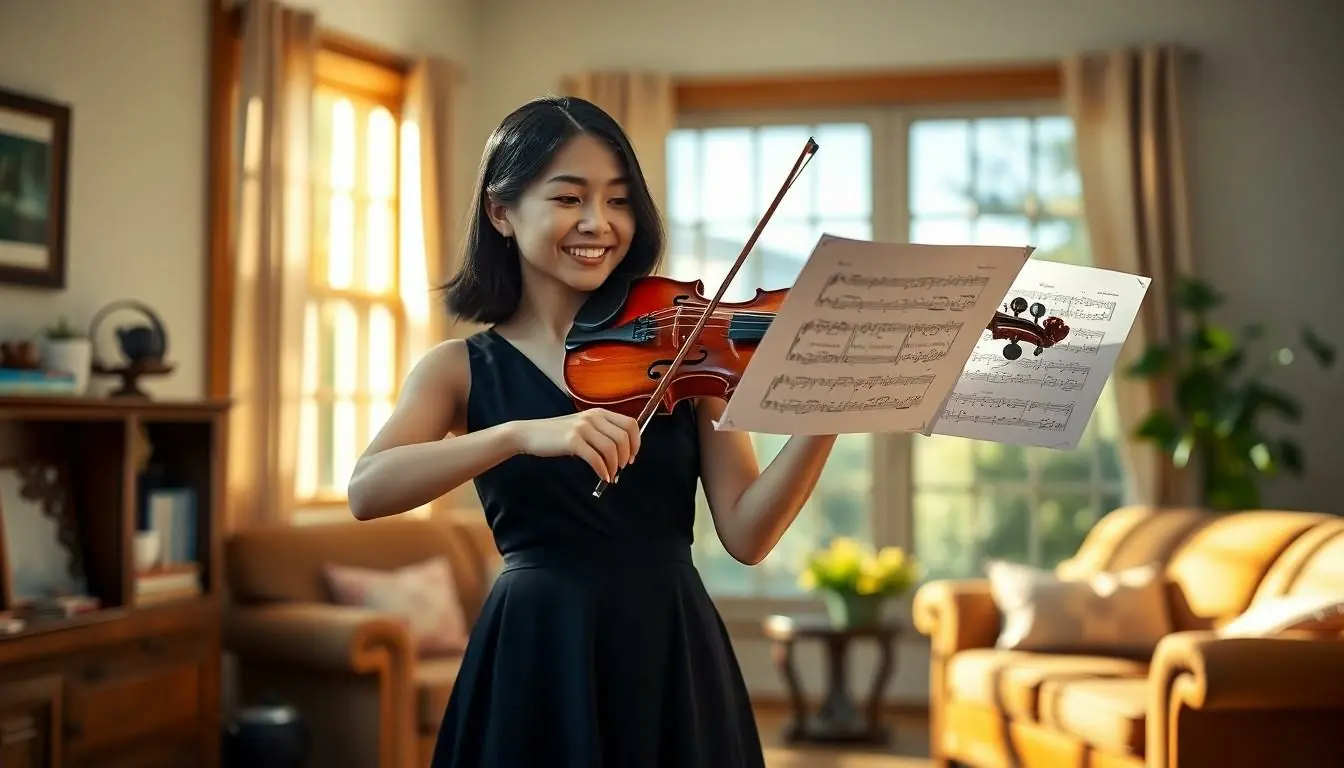Classical violin sheet music isn’t just a collection of notes; it’s a ticket to a world where emotions dance and stories unfold. Whether you’re a seasoned virtuoso or a budding beginner, diving into this treasure trove can turn any living room into a grand concert hall. Who wouldn’t want to channel their inner virtuoso and impress their cat with a rendition of Vivaldi?
Table of Contents
ToggleImportance Of Classical Violin Sheet Music
Classical violin sheet music serves as a foundation for musical education and performance. Each piece offers unique technical challenges that enhance a musician’s skills. Mastery of these compositions showcases the player’s dedication and artistic expression.
Beyond technique, sheet music conveys rich emotional narratives. Composers like Bach and Mozart wrote pieces that evoke a spectrum of feelings, allowing performers to communicate with their audiences. Engaging with these scores fosters a deeper connection with the music.
Various genres within classical music present opportunities for growth. Baroque compositions demand precision, while Romantic pieces invite expressiveness. Exploring different styles enriches musical understanding and versatility.
Sheet music also promotes collaboration among musicians. Playing in ensembles or orchestras requires familiarity with written scores. This collaboration cultivates teamwork, discipline, and a sense of community among performers.
Access to classical violin sheet music is vital for both practice and performance. Resources such as digital libraries and music schools provide a wealth of material for players at every level. Engaging with this repertoire provides continual inspiration and motivation.
Ultimately, classical violin sheet music is an essential tool for any musician. Its capacity to teach, inspire, and connect makes it invaluable. Whether performing for an audience or simply enjoying personal practice, these scores unlock endless possibilities in musical exploration.
Types Of Classical Violin Sheet Music

Classical violin sheet music encompasses various types, each offering unique experiences for performers.
Solo Works
Solo violin pieces highlight the instrument’s expressive capabilities. Compositions by Bach, such as the “Partitas” and “Sonatas,” stand out for their technical challenges and emotional depth. Performers showcase individual artistry through phrases and dynamics, transforming familiar compositions into personal interpretations. Moreover, contemporary solo works continue to enrich the repertoire, providing fresh perspectives for today’s violinists.
Chamber Music
Chamber music arrangements involve collaboration among musicians, allowing violinists to engage with a variety of instruments. Duets, trios, and quartets create a rich tapestry of sound, with works like Mozart’s “Divertimenti” and Dvořák’s “Slavonic Dances” being particularly notable. Each player contributes to the overall performance, fostering communication and shared artistic expression. Engaging with chamber music enhances a musician’s skill in listening and adapting, essential attributes for any ensemble performance.
Orchestral Scores
Orchestral scores present concert opportunities for violinists in an ensemble setting. Works by composers like Tchaikovsky and Beethoven require attention to both individual parts and the collective dynamic. Timing, precision, and unity become crucial as musicians navigate complex scores and harmonies. Experience with orchestral literature not only prepares players for performances but also develops a deeper understanding of orchestration and collaborative musicianship.
Notable Composers Of Classical Violin Music
Classical violin music features a number of influential composers whose works remain fundamental in the repertoire. These composers shaped the landscape of violin music and continue to inspire musicians today.
Bach
Johann Sebastian Bach stands as a towering figure in classical music. His compositions for violin, particularly the “Sonatas” and “Partitas,” showcase intricate counterpoint and emotional depth. Each piece presents technical challenges that demand precision and artistry. Musicians frequently study Bach’s works to develop their expressiveness and interpretative skills. Additionally, these compositions offer insights into Baroque aesthetics, allowing performers to connect with historical practices. The enduring popularity of Bach’s violin music highlights his impact on the classical tradition.
Beethoven
Ludwig van Beethoven revolutionized violin music with his innovative approaches. His “Violin Concerto in D Major” exemplifies the transition from Classical to Romantic styles. Complex themes, dramatic contrasts, and lyrical passages define his compositions. Musicians benefit from tackling Beethoven’s works, enhancing their technical and emotional interpretation. The concerto’s dynamic range challenges players, emphasizing the violin’s expressive capabilities. Beethoven’s influence is evident in how future composers expanded on his foundations, making his music essential for any violinist’s repertoire.
Tchaikovsky
Pyotr Ilyich Tchaikovsky contributed significantly to the violin repertoire with his vibrant compositions. His “Violin Concerto in D Major” captures both virtuosity and lyricism. Rich, sweeping melodies and technical demands create an engaging experience for performers and audiences alike. Tchaikovsky’s emotional intensity resonates deeply with listeners, adding to the appeal of his music. Musicians find that mastering this concerto not only showcases their skills but also connects them to the Romantic spirit. Tchaikovsky’s legacy persists as his works remain popular in concert halls worldwide.
Tips For Choosing The Right Sheet Music
Selecting the right classical violin sheet music greatly impacts a musician’s growth and enjoyment. A few key factors come into play when making this choice.
Skill Level Considerations
Skill level significantly influences the selection of sheet music. Beginners benefit from pieces containing simpler rhythms and accessible fingerings. Intermediate players might seek works that challenge their technique while exposing them to varied styles. Advanced musicians often prefer complex compositions that showcase their skills and emotional expression. Choosing pieces that align closely with one’s ability can lead to a more fulfilling practice experience.
Performance Context
Performance context plays a crucial role in determining suitable sheet music. Solo performances often require pieces that highlight a violinist’s strengths and interpretative abilities. When participating in chamber ensembles, musicians should consider arrangements that facilitate collaboration and interaction with fellow players. Orchestral performances necessitate selecting scores that emphasize timing, dynamic contrast, and ensemble cohesion. Knowing the performance setting provides guidance for choosing appropriate and impactful pieces.
Classical violin sheet music serves as a vital resource for musicians at every level. It not only enhances technical skills but also fosters emotional connections between performers and their audiences. The diverse genres and styles within classical music offer endless opportunities for exploration and growth.
Whether playing solo, in a chamber group, or with an orchestra, each piece presents unique challenges that contribute to a musician’s development. The right selection of sheet music can inspire creativity and joy in practice and performance. Embracing classical violin music opens doors to a world of artistic expression and collaboration, making it an indispensable part of any musician’s journey.


